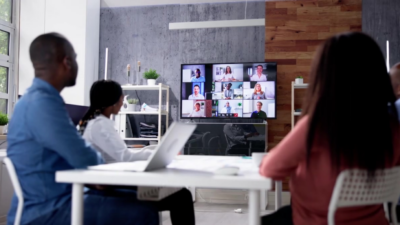This article is the first in a series on the evolution of workplace innovation. Next in the series: Five Metrics for Designing Today’s Workspace.
The open office—large, open rooms that eliminate individual office spaces—is a hallmark of late 20th-century office design. Completely open office plans have been the standard for tech companies in the 90s and early 2000s because they were seen as places where employees could brainstorm, innovate and communicate openly.
But recent studies show that open office plans can produce negative effects, including decreased productivity, memory and focus problems, as well as higher rates of physical illness from chronic noisiness and fast-spreading disease.
One recent study by Harvard Business School professor Ethan Bernstein concluded that open office workplaces decreased face-to-face conversation between coworkers by 72%. Why? Think pseudo privacy barriers, like headphones, that actually make it more difficult to communicate. That study was narrow, and other space options for the occupants were not available. But the fact remains—there are no studies that prove entirely open spaces are better, and many that prove they are, in fact, worse for employees.
Recent research by YouGov has uncovered some of the problems of open office plans—limited to no space for private calls, meetings and focused work. Among surveyed employees, 31% reported having to go to a closet or hall to make a call. Similarly, large percentages felt stressed and less productive. This information begs the question: are open plan designs driving behaviors that don’t deliver the workplace experience once thought?
However, this doesn’t mean office design should swing to the opposite end of the pendulum and embrace private offices for everyone.
While evidence is mounting against having fully open plans, there is no single study that concludes how much of an office should be open versus closed. It’s simply not a one size fits all answer. Every workplace needs to be tailored to the unique functional and cultural needs of each organization—what works for a company like Google may not work for a company like Accenture or even another tech firm like Adobe, for example. The solution to what makes a well-designed office space—and how open or closed that space should be—must be specific to the users.
To Create Innovative Office Spaces, Individualize
We faced this issue head on when we redesigned the Colliers Chicago space. Like many of our clients, our employees were wary of the open office, and more specifically, “unassigned work environments.” They had heard about or even experienced completely open work environments—and wanted none of it. So we brought in our workplace strategy team to consult on the design solution. We sought to answer five key questions and identify the habits of the employees, their view on what they need for productivity and their desires in an office space. If the evidence indicated we should eliminate private offices, these findings would be reflected in the office design.
There are five questions we ask in designing a workplace strategy:
- How do you work best?
- How can the culture spark new ideas and drive innovative solutions?
- What activities and functions does the space need to support?
- What messages do you want to send to potential talent and clients?
- What kinds of experiences do you want to create for employees and clients?
Throughout this process, we emphasized the need for evidence upon which to base decisions and prioritize spending. We strive not to make assumptions based on design trends or what has worked with other companies. We were solving a business problem, not a design problem.
As part of our discovery, we conducted an employee survey to identify what they deemed most important for the new office environment. With survey results, we examined four primary data points related to the Chicago office:
- We studied how employees were currently using their office spaces. These facts dispelled a lot of myths but provided important insights about how we worked. Nearly 90% of work was individual work, and much of this work was done virtually. Meetings are small, with typically two to four people. Since there weren’t places to informally collaborate much of the work was conducted in the private offices.
- The work we do. We surveyed our employees to understand what behaviors and activities helped them be successful and who they typically worked with. We didn’t ask what they wanted to do. We asked them what they did.
- Cultural assessment. We worked with leaders and employees through surveys, interviews, digital voting and focus groups to look at which aspects of our current culture we needed to keep and which aspects we desired to change.
- Finally, we looked at what leading companies are doing to see if their solutions could inform ours. We were determined not to borrow ideas, but instead let them flavor our strategy.
Our findings determined that many of our Colliers Chicago sales professionals needed private spaces for both confidentiality and focus work. A completely open work environment simply wouldn’t work for the culture and functions leadership wanted to encourage, but rather a mix of private and collaborative spaces were necessary to support work functions. We also learned from our professionals the importance of having strong line-of-sight to their teams and on-demand meeting areas would be essential to their success.
This data-driven approach led to a list of five primary design considerations:
- Employees expressed that daylight access was important to their well-being and productivity. They wanted a bright space that allowed everyone daylight access and we created a design where 100% of staff have direct access to the light and skyline views from sit-to-stand desks.
- Support the work. The space needed to streamline, and support work processes and we needed to make it easier for teams to work together on projects, but also provide individuals space to work privately. Team spaces were designed for small teams, including a mixture of open and closed spaces directly adjacent to shared rooms for strategy meetings or client interactions.
- To create an authentic workplace experience for employees, partners and clients to enjoy and use, a diverse group of employees were engaged and formed two teams focused on both the employee and client experience. This stimulated innovative ideas and allowed for full participation and ownership in creating new work environments.
- It was important that the office environment foster innovation and function as an idea generator. To enable creative thinking, the space includes a hub and coffee area to encourage casual collaboration. The sizes of enclosed offices were reduced to provide more room for common and teaming spaces.
- Lastly, while integrating higher levels of transparency to create a positive vibe in the space, adequate visual and acoustic privacy was incorporated by adding enclosed focus and phone rooms for those working at workstations.
The Colliers Chicago office is a balance between open and closed spaces. It’s a welcoming mix of community spaces for collaboration and private, comfortable spaces for one-on-one meetings with clients and focused work.
What Do Individualized Solutions Look Like?

Future innovation in workplace design is less about the space, and more about strategies for using the space. An open or closed workplace design matters less than an office design based on facts and evidence specific to the company’s needs and desired outcomes. We’re applying this idea to create customized spaces that reflect each clients’ unique needs and desired cultural environment.
What we’ve found in our own offices is that the same solution doesn’t fit every situation. To be progressive, our space didn’t need every innovative concept in office design—it needed those that work for our team. This same customized approach brings value to our clients and results in more enterprising client solutions.
Our experience in our Chicago office has informed, but has not dictated two other projects, one in Atlanta, and one in Silicon Valley.
In Atlanta, we designed an open office with an unassigned benching system. This setup of shared workspaces was the right solution for them because the majority of the office is highly mobile, often working remotely or at other locations, and intensely collaborative when they are in the office. Enclosed one-person phone booths are provided for private phone calls and heads-down work.
In San Jose, we designed a Silicon Valley office to reflect the tech industry in every aspect of the workplace design. Although it’s a tech-rich space, the office was designed to adapt and change quickly with evolving technology. We worked to future-proof the space so it can evolve as technology and the work practices evolve.
These three recent Colliers office redesigns have challenged our Workplace team to explore what the workplace must be in 2019 and beyond. We know a successful workplace does three things: it’s a place employees want to be and allows them to work at their best, it authentically supports the organization’s culture and function and it can easily evolve with the client’s business strategy.

 Workplace Advisory
Workplace Advisory
 Anthony Shell
Anthony Shell
 Andrew Steele
Andrew Steele
 Aaron Jodka
Aaron Jodka Michelle Cleverdon
Michelle Cleverdon